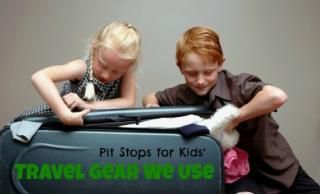We love outdoor travel here at Pit Stops for Kids, but we hate mosquitos. We really, really hate them. We know DEET is terrible for us, but it’s a shame, because it’s the only thing that really repels them. However, when outdoors exploring, we have found a few mosquito relief products for kids that offer solutions. (We were not compensated for this post. Have I mentioned that we hate mosquitos?)

Be Koool Itch Relief Patches:
If mosquitos are annoying, mosquito bites are even more so. We’ve learned they can be a health hazard as well. Kids with itchy bites scratch them (heck, so do adults), leading to open cuts…not ideal hygiene while traveling in the outdoors. Bites that are scratched can become infected, and at the very least, cannot be kept clean.
On our most recent foray into the woods, we came armed with Be Koool’s Itch Relief Patches. These little circular stickers apply directly to the skin, and are medicated with lidocaine and menthol. These are the same ingredients in most anti-itch sprays and lotions, but the stickers are much less messy. Plus, after applying one, it naturally stops your child from itching the spot.
Did it work? Yes! We’re not sure whether the medication helped stop the itch, or simply the barrier from itching, but either way, little fingers were off of bug bites for the afternoon. We’ll keep some patches in our outdoor first aid kit from now on.
When patches will NOT work: The patches don’t stay on while swimming, and shouldn’t be used for serious bites (like intense spider bites). We had some trouble with the patches sticking to one another when we tried to get one from the package; our solution was to keep the various sheets of stickers apart from one another in our day pack.
Buy BeKoool Itch Relief Patches on Amazon or at any drugstore.

Mosquitno Citronella Armband:
You know those citronella candles for your picnic table? Well, Mosquitno has come up with the mobile version. Their rubber wristbands are stylish (though how these popular bands became so trendy I’ll never know) and come in fun colors. They even have fun saying on them, like ‘Please don’t bite me.’ Well said. They smell pretty good too.
Do they work? Yes, pretty well. They will not keep mosquitos at bay entirely (I miss my DEET), but they do just as well as most over-the-counter sprays and are much healthier for your skin. Any product that saturates my kids’ skin I don’t like…unless it’s DEET. (Just kidding, of course.) We took Mosquitnos on a test drive on an overnight backpacking trip, and while our kids still got some bites, they were much more willing to wear the wristband than get slathered in repellant. The bands apparently work for up to 150 hours (though we noticed their scent doesn’t last that long), and come in a five-pack (or one for $2.99). Find them at most stores or buy Mosquito Insect Repellent Wrist Bands on Amazon.
amzn_assoc_placement = “adunit0”;
amzn_assoc_search_bar = “true”;
amzn_assoc_tracking_id = “pitstoforkid-20”;
amzn_assoc_ad_mode = “manual”;
amzn_assoc_ad_type = “smart”;
amzn_assoc_marketplace = “amazon”;
amzn_assoc_region = “US”;
amzn_assoc_title = “My Amazon Picks”;
amzn_assoc_asins = “B0080EEMCA,B0054QBBEE,B001G7QRC6,B011A930EW”;
amzn_assoc_linkid = “483819fecf872fb1619785fd708fb419”;
Toad & Co DeBug Ground Cover:
Do you camp in areas with mosquitos or other pesky insects? How about picnic? We love this new ground cover, which is treated with Toad & Co’s insect shield technology, guaranteed for 70 washes. This blanket goes in the back of our car for every camping trip!
Natrapel tent and clothing spray:
While I was not compensated for this post, I was given a package of Be Koool and Mosquitno for the purpose of review.














 Did you know there was such thing as a sleeping quilt or backcountry quilt? These ‘sleeping bags’ don’t zip all the way around, which prevents that clammy, enclosed feeling some of us just can’t stand. If you’d rather sleep outdoors under a blanket or quilt than in a sleeping bag (but still need the warmth of a bag),
Did you know there was such thing as a sleeping quilt or backcountry quilt? These ‘sleeping bags’ don’t zip all the way around, which prevents that clammy, enclosed feeling some of us just can’t stand. If you’d rather sleep outdoors under a blanket or quilt than in a sleeping bag (but still need the warmth of a bag),  If you need a solid sleeping bag for a family member that is rated to 20 degrees for three-season comfort in the backcountry, you don’t have to break the bank. The Kelty Cosmic 20 gets our pick for the best bag for your buck. It’s only $149, and while a little heavier than most bags, you still get DriDown, Kelty’s down blend that resists moisture (so you don’t get that soggy, damp issue with your down sleeping bag after being dusted with morning dew). You also get a draft collar, a feature that used to be found only on more expensive models. It packs down into a stuff sack, though again, it won’t be as compressible as it’s more expensive cousin, the SB20.
If you need a solid sleeping bag for a family member that is rated to 20 degrees for three-season comfort in the backcountry, you don’t have to break the bank. The Kelty Cosmic 20 gets our pick for the best bag for your buck. It’s only $149, and while a little heavier than most bags, you still get DriDown, Kelty’s down blend that resists moisture (so you don’t get that soggy, damp issue with your down sleeping bag after being dusted with morning dew). You also get a draft collar, a feature that used to be found only on more expensive models. It packs down into a stuff sack, though again, it won’t be as compressible as it’s more expensive cousin, the SB20. The Sierra Design
The Sierra Design 









